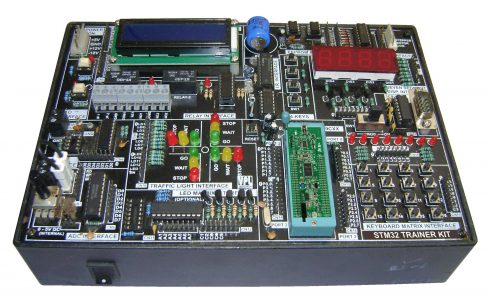Edge Device Development Board (VPL-EDGE)
Hardware Overview
- Processor: ARM Cortex-M4 32-bit RISC core optimized for low-power, real-time operation
- Clock Speed: 80 MHz
- Memory: Internal RAM 128 KB or better, Internal Flash 1 MB or more
- Connectivity:
- ARDUINO® Uno V3 Compatibility:
- Digital I/O
- I2C
- SPI
- UART
- Analog I/O
- PWM
- ARDUINO® Uno V3 Compatibility:
- On-Board Capabilities:
- Debugger/Programmer: On-board debugger/programmer with USB re-enumeration capability (mass storage, Virtual COM port, debug port)
- User Input/Output:
- User programmable LEDs and button
- MCU current measurement point
- USB Power Management: Efficient USB power management for easy integration
Key Concepts – Edge AI Board:
- Edge AI: The processor is designed to handle complex AI algorithms at the edge, enabling real-time processing without cloud dependency.
- Low-Power Operation: The ARM Cortex-M4 core is optimized for low-power applications, making it ideal for battery-operated edge devices.
- Connectivity and Expansion: With ARDUINO® Uno V3 support, the board is equipped for a wide range of peripherals and connectivity options, including I2C, SPI, UART, and PWM.
- Real-Time Processing: The high clock speed and internal memory ensure efficient handling of AI models and data processing tasks in real-time.
- USB Management: USB power management and re-enumeration enhance flexibility in device connection and data handling.
Experiment List
- Basic STM32 Programming on In-Built LED
-
- Objective: Learn the basics of STM32 programming by toggling an onboard LED.
- Key Concepts: STM32CubeIDE setup, GPIO configuration, LED control, delay functions.
- Toggling a LED using a USR Button in STM32CubeIDE
-
- Objective: Configure and program the onboard user button to control an LED.
- Key Concepts: GPIO input configuration, button state detection, LED toggling.
- Toggling a LED using Interrupt in STM32CubeIDE
-
- Objective: Implement interrupt-based input handling for the user button.
- Key Concepts: External interrupts, interrupt service routines (ISR), event-driven programming.
- Serial Communication Protocol (UART)
-
- Objective: Implement UART communication for data transfer between the Edge AI board and a PC.
- Key Concepts: UART configuration, data transmission, serial debugging.
- Serial Communication Protocol (UART) with Printf
-
- Objective: Use printf statements to send formatted data from the Edge AI board to a PC via UART.
- Key Concepts: UART data formatting, debugging techniques, serial communication monitoring.
- Sensor Data Logging Methodology (Method 1)
-
- Objective: Design a data logging methodology for acquiring sensor data.
- Key Concepts: Sensor initialization, data logging, and storage.
- Sensor Data Logging Methodology (Method 2)
-
- Objective: Implement an alternative data logging method for acquiring sensor data and optimizing it for AI training.
- Key Concepts: Real-time sensor data processing, data optimization.
- Running a Data Logger Code and Building an AI Model
-
- Objective: Collect data and train an AI model for classification.
- Key Concepts: Data collection, ML model training, real-time classification.
- Image Classification with Pre-Trained Models
-
- Objective: Classify images using pre-trained deep learning models.
- Key Concepts: Image classification, transfer learning, model evaluation.
- Real-Time Emotion Recognition
-
- Objective: Recognize and classify emotions from facial expressions using the camera module.
- Key Concepts: Emotion classification, facial feature extraction, AI model deployment.
- Audio Scene Classification Using Machine Learning
-
- Objective: Implement a machine learning model to classify various sounds.
- Key Concepts: Feature extraction, sound classification, machine learning model.
- Gesture Recognition Using Motion Sensor Data
-
- Objective: Train and deploy a gesture recognition model based on motion sensor data.
- Key Concepts: Gesture classification, motion sensor data, TensorFlow Lite.
- Vibration-Based Predictive Maintenance Using Machine Learning
-
- Objective: Develop and deploy an ML model to detect and classify abnormal vibration patterns.
- Key Concepts: Anomaly detection, predictive maintenance, AI-powered fault detection.
- 1-Class Model for Ultrasonic Sensor Data
-
- Objective: Use NanoEdge AI to detect irregularities based on ultrasonic sensor data.
- Key Concepts: One-class classification, ultrasonic sensor data, anomaly detection.
Platform and Workstation Details
Training Environment Setup:
- Display: 4 Inch capacitive touch LCD for user interaction with the Edge AI system.
- Connectivity: USB OTG, I2C, SPI, UART for various external device interfaces.
- Power Supply: Powered via USB or external sources for stable operation.
- Enclosure: Plastic enclosure for durability and protection in industrial environments.

